Multiple Choice
Identify the
choice that best completes the statement or answers the question.
|
|
|
1.
|
Which of the following words and phrases best captures the notion of
equality?
a. | minimum waste | b. | maximum benefit | c. | sameness | d. | efficiency |
|
|
|
2.
|
Which of the following is a principle concerning how people interact?
a. | Markets are usually a good way to organize economic activity. | b. | Rational people
think at the margin. | c. | People respond to
incentives. | d. | All of the above are correct. |
|
|
|
3.
|
A company that formerly produced software went out of business because too many
potential customers bought illegally-produced copies of the software instead of buying the product
directly from the company. This instance serves as an example of
a. | market power. | b. | inefficient trade. | c. | inadequate
enforcement of property rights. | d. | the invisible hand at
work. |
|
|
|
4.
|
Market power refers to the
a. | power of a single person or small group to influence market
prices. | b. | ability of a person or small group to successfully market new
products. | c. | power of the government to regulate a market. | d. | importance of a
certain market in relation to the overall economy. |
|
|
|
5.
|
Which of the following is an important cause of inflation in an economy?
a. | increases in productivity in the economy | b. | the influence of
positive externalities on the economy | c. | lack of property rights in the
economy | d. | growth in the quantity of money in the economy |
|
|
|
6.
|
An economic theory about international trade that is based on the assumption
that there are only two countries trading two goods
a. | is useless, since the real world has many countries trading many
goods. | b. | can be useful only in situations involving two countries and two
goods. | c. | can be useful in the classroom, but is useless in the real world. | d. | can be useful in
helping economists understand the complex world of international trade involving many countries and
many goods. |
|
|
|
7.
|
A model can be accurately described as a
a. | theoretical abstraction with very little value. | b. | device that is
useful only to the people who created it. | c. | realistic and carefully constructed
theory. | d. | simplification of reality. |
|
|
|
Figure 1
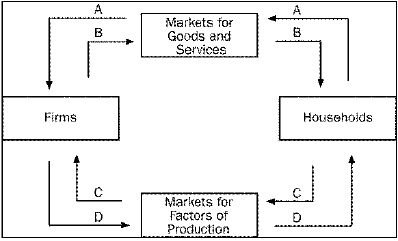
|
|
|
8.
|
Refer to Figure 1. Julio buys a new pair of shoes at a shoe
store. To which of the arrows does this transaction directly contribute?
a. | A only | b. | A and B | c. | C
only | d. | C and D |
|
|
|
9.
|
When an economy is operating inside its production possibilities frontier, we
know that
a. | there are unused resources or inefficiencies in the economy. | b. | all of the
economy’s resources are fully employed. | c. | economic growth would have to occur in order
for the economy to move to a point on the frontier. | d. | in order to produce more of one good, the
economy would have to give up some of the other good. |
|
|
|
Figure 2
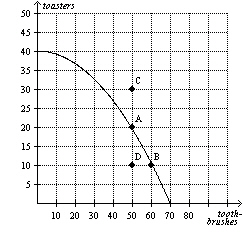
|
|
|
10.
|
Refer to Figure 2. It is possible for this economy to produce
a. | 40 toothbrushes and 20 toasters. | b. | 50 toothbrushes and 30
toasters. | c. | 70 toothbrushes and 40 toasters. | d. | All of the
above. |
|
|
|
11.
|
Which of the following is an example of a normative, as opposed to positive,
statement?
a. | The price of gasoline came down sharply during the second half of
2006. | b. | If the government were to set a maximum legal price on gasoline, then there would be
a shortage of gasoline. | c. | Income taxes should be
reduced. | d. | The federal government obtains much of its revenue from income
taxes. |
|
|
|
12.
|
If Shawn can produce more donuts in one day than Sue can produce in one day,
then
a. | Shawn has a comparative advantage in the production of donuts. | b. | Sue has a
comparative advantage in the production of donuts. | c. | Shawn has an absolute advantage in the
production of donuts. | d. | Sue has an absolute advantage in the production
of donuts. |
|
|
|
Table 1
Assume that Aruba and Iceland can switch between
producing coolers and producing radios at a constant rate. | | Labor Hours
Needed to Make
1 | Cooler | Radio | | Aruba | 2 | 5 | | Iceland | 1 | 4 | | | |
|
|
|
13.
|
Refer to Table 1. Aruba’s opportunity cost of one cooler
is
a. | 0.4 radio and Iceland’s opportunity cost of one cooler is 0.25
radio. | b. | 0.4 radio and Iceland’s opportunity cost of one cooler is 4
radios. | c. | 2.5 radios and Iceland’s opportunity cost of one cooler is 0.25
radio. | d. | 2.5 radios and Iceland’s opportunity cost of one cooler is 4
radios. |
|
|
|
Table 2
Assume that the farmer and the rancher can switch
between producing meat and producing potatoes at a constant rate.
| | Labor Hours Needed
to Make 1
Pound of | Pounds Produced
in 40 Hours | Meat | Potatoes | Meat | Potatoes | | Farmer | 10 | 2 | 4 | 20 | | Rancher | 4 | 8 | 10 | 5 | | | | | |
|
|
|
14.
|
Refer to Table 2. Which of the following combinations of meat and
potatoes could the rancher not produce in 40 hours?
a. | 2.5 pounds of meat and 3.75 pounds of potatoes. | b. | 5 pounds of meat and
2.5 pounds of potatoes. | c. | 7.5 pounds of meat and 1.25 pounds of
potatoes. | d. | 10 pounds of meat and 0.5 pound of potatoes. |
|
|
|
15.
|
Refer to Table 2. The farmer has an absolute advantage in the
production of
a. | meat. | b. | potatoes. | c. | both
goods. | d. | neither good. |
|
|
|
Table 3
Assume that England and Spain can switch between
producing cheese and producing bread at a constant rate.
| | Labor Hours Needed
to Make 1
Unit of | Number of Units
Produced in 40 Hours | Cheese | Bread | Cheese | Bread | | England | 1 | 4 | 40 | 10 | | Spain | 4 | 8 | 10 | 5 | | | | | |
|
|
|
16.
|
Refer to Table 3. We could use the information in the table to draw a
production possibilities frontier for England and a second production possibilities frontier for
Spain. If we were to do this, measuring bread along the horizontal axis, then
a. | the slope of England’s production possibilities frontier would be -4 and the
slope of Spain’s production possibilities frontier would be -2. | b. | the slope of
England’s production possibilities frontier would be -0.25 and the slope of Spain’s
production possibilities frontier would be -0.5. | c. | the slope of England’s production
possibilities frontier would be 0.25 and the slope of Spain’s production possibilities frontier
would be 0.5. | d. | the slope of England’s production possibilities frontier would be 4 and the
slope of Spain’s production possibilities frontier would be 2. |
|
|
|
17.
|
Refer to Table 3. If England and Spain each spends all its time
producing the good in which it has a comparative advantage and the countries agree to trade 2 units
of bread for 6 units of cheese, then England will consume
a. | 34 units of cheese and 2 units of bread and Spain will consume 6 units of cheese and
3 units of bread. | b. | 34 units of cheese and 2 units of bread and
Spain will consume 16 units of cheese and 3 units of bread. | c. | 34 units of cheese
and 12 units of bread and Spain will consume 6 units of cheese and 3 units of
bread. | d. | 34 units of cheese and 12 units of bread and Spain will consume 16 units of cheese
and 3 units of bread. |
|
|
|
Figure 3Bolivia’s Production Possibilities
Frontier
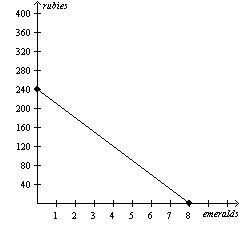
|
|
|
18.
|
Refer to Figure 3. Suppose Bolivia decides to increase its
production of emeralds by 2. What is the opportunity cost of this decision?
a. | 30 rubies | b. | 40 rubies | c. | 60
rubies | d. | 120 rubies |
|
|
|
Figure 4
| Bob’s Production Possibilities Frontier | Enid’s Production Possibilities Frontier | | |
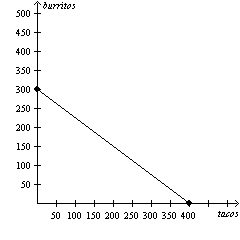 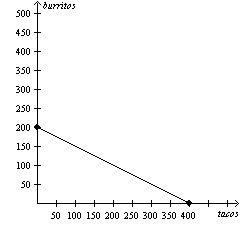
|
|
|
19.
|
Refer to Figure 4. If the production possibilities frontier shown
for Bob is for 100 hours of production, then how long does it take Bob to make one burrito?
a. | 1/4 hour | b. | 1/3 hour | c. | 3
hours | d. | 4 hours |
|
|
|
Figure 5
| Maxine’s Production Possibilities
Frontier | Daisy’s
Production Possibilities Frontier | | |
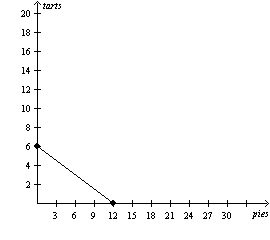 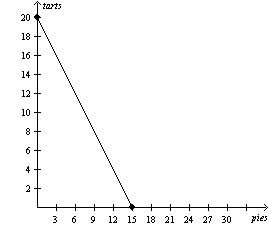
|
|
|
20.
|
Refer to Figure 5. If the production possibilities frontiers shown
are each for one day of work, then which of the following combinations of pies and tarts could Maxine
and Daisy together make in a given day?
a. | 6 pies and 24 tarts | b. | 8 pies and 22 tarts | c. | 14 pies and 18
tarts | d. | 18 pies and 14 tarts |
|
|
|
Figure 6
| Bintu’s Production Possibilities Frontier | Juba’s Production Possibilities Frontier | | |
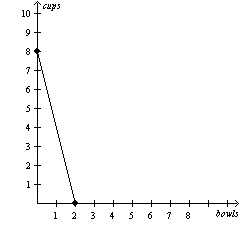 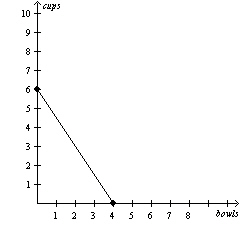
|
|
|
21.
|
Refer to Figure 6. If Bintu and Juba both spend all of their time
making bowls, then total production is
a. | 2 bowls. | b. | 3 bowls. | c. | 4
bowls. | d. | 6 bowls. |
|
|
|
22.
|
Refer to Figure 6. The opportunity cost of 1 cup for Bintu
is
a. | 1/8 bowl. | b. | 1/4 bowl. | c. | 4
bowls. | d. | 8 bowls. |
|
|
|
23.
|
The forces that make market economies work are
a. | work and leisure. | b. | politics and religion. | c. | supply and
demand. | d. | taxes and government spending. |
|
|
|
24.
|
The law of demand states that, other things equal,
a. | when the price of a good falls, the demand for the good rises. | b. | when the price of a
good rises, the quantity demanded of the good rises. | c. | when the price of a good rises, the demand for
the good falls. | d. | when the price of a good falls, the quantity demanded of the good
rises. |
|
|
|
25.
|
The following table contains a demand schedule for a good. Price | Quantity Demanded | $10 | 100 | $20 | X | | |
If the law of demand applies to this good,
then “X” could be
|
|
|
26.
|
A market demand curve shows how the total quantity demanded of a good varies
as
a. | income varies. | b. | price varies. | c. | the number of buyers
varies. | d. | supply varies. |
|
|
|
27.
|
If buyers today become more willing and able than before to purchase larger
quantities of Vanilla Coke at each price of Vanilla Coke, then
a. | we will observe a movement downward and to the right along the demand curve for
Vanilla Coke. | b. | we will observe a movement upward and to the left along the demand curve for Vanilla
Coke. | c. | the demand curve for Vanilla Coke will shift to the right. | d. | the demand curve for
Vanilla Coke will shift to the left. |
|
|
|
Figure 7
Panel (a) | Panel (b) | 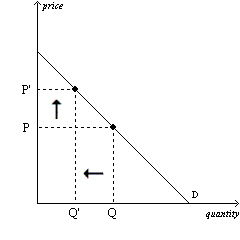 | 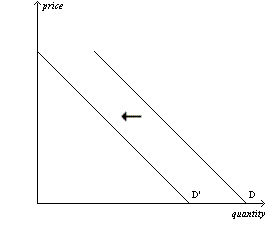 | | |
|
|
|
28.
|
Refer to Figure 7. The graphs show the demand for cigarettes.
In Panel (a), the arrows are consistent with which of the following events?
a. | Tobacco and marijuana are complements and the price of marijuana
decreased. | b. | Tobacco is a “gateway drug” and the price of marijuana
increased. | c. | The price of cigarettes increased. | d. | The arrows are consistent with all of these
events. |
|
|
|
29.
|
The supply curve for a good is
a. | a line that relates profit and quantity supplied. | b. | a line that relates
input prices and quantity supplied. | c. | a line that relates price and quantity
supplied. | d. | a line that relates price and profit. |
|
|
|
Table 3Price | Firm A’s
Quantity
Supplied | Firm
B’s
Quantity
Supplied | Firm C’s
Quantity
Supplied | Firm D’s
Quantity
Supplied | $0 | 10 | 0 | 0 | 0 | $2 | 8 | 3 | 4 | 5 | $4 | 6 | 6 | 8 | 10 | $6 | 4 | 9 | 12 | 15 | $8 | 2 | 12 | 8 | 20 | $10 | 0 | 15 | 4 | 25 | | | | | |
|
|
|
30.
|
Refer to Table 3. If these are the only four sellers in the market,
then the market quantity supplied at a price of $4 is
a. | 4 units. | b. | 7.5 units. | c. | 10
units. | d. | 30 units. |
|
|
|
31.
|
A rightward shift of a supply curve is called
a. | an increase in supply. | b. | a decrease in supply. | c. | a decrease in
quantity supplied. | d. | an increase in quantity
supplied. |
|
|
|
32.
|
A movement downward and to the left along a supply curve is called
a. | an increase in supply. | b. | a decrease in supply. | c. | a decrease in
quantity supplied. | d. | an increase in quantity
supplied. |
|
|
|
33.
|
A decrease in the price of a good will
a. | increase supply. | b. | decrease supply. | c. | increase quantity
supplied. | d. | decrease quantity supplied. |
|
|
|
34.
|
If there is a shortage of farm laborers, we would expect
a. | the wage of farm laborers to increase. | b. | the wage of farm laborers to
decrease. | c. | the price of farm commodities to decrease. | d. | a decrease in the
demand for substitutes for farm labor. |
|
|
|
Figure 8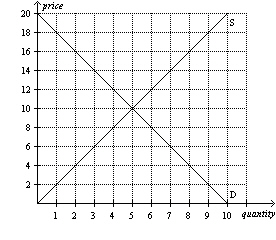
|
|
|
35.
|
Refer to Figure 8. At a price of $12, which of the following is
correct?
a. | there is a surplus of 1 unit | b. | there is a surplus of 2
units | c. | there is a shortage of 1 unit | d. | there is a shortage of 2
units |
|
|
|
36.
|
Consider the market for new DVDs. If DVD players became cheaper, buyers
expected DVD prices to fall next year, used DVDs became more expensive, and DVD production technology
improved, then we could safely conclude that the equilibrium price of a new DVD would
a. | rise. | b. | fall. | c. | stay the
same. | d. | We couldn't be sure what it might do. |
|
|
|
37.
|
Equilibrium quantity will unambiguously increase when
a. | demand increases and supply does not change, when demand does not change and supply
increases, and when both demand and supply increase. | b. | demand increases and supply does not change,
when demand does not change and supply increases, and when both demand and supply
decrease. | c. | demand decreases and supply does not change, when demand does not change and supply
decreases, and when both demand and supply increase. | d. | demand decreases and supply does not change,
when demand does not change and supply decreases, and when both demand and supply
decrease. |
|